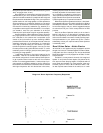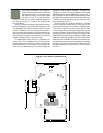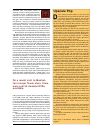
was withdrawn from its shell and consigned to its whirring
drawer mechanism. Messages darted again over the screens,
followed by music that materialized throughout the room, a
large gentle beast trembling the wooden floor, stalking along
the walls, palpating the window panes.
In the Company of the Beast
I am listening as I write this to the latest release on the Water
Lily Acoustics label, entitled Fascinoma, a virtuoso vehicle
for trumpeter Jon Hassell in collaboration with Ry Cooder,
Ronu Majumdar on flute, and Jacky Terrasson on piano. A
point of special interest is that before developing his Fourth
World style, Hassel worked with Stockhausen and thereby
acquired the technique and aesthetics of electro-acoustic
composition. He now routinely incorporates loops and sam-
ples into his music as an accompanying ground bass.
On track 3, the entry of the synthesized percussion loops
explodes into the room with the intensity of a seismic tremor
over which Hassel floats the gossamer threads of his muted
trumpet tone like an impressionistic Milky Way serenely arch-
ing over a landscape in turmoil. The bass energy in this
recording is remarkable, but it demands a great deal of the
system to faithfully reproduce this together with the accom-
panying delicate and discrete strands of musical information.
If the system can cope, the assembled illuminati weave a
tapestry of surpassing richness within the ample acoustic of the
stone chapel in Santa Barbara, California, in which Kavi
Alexander has made so many remarkable recordings. So wide
is the dynamic range of this recording that the demand for the
system not to sound strained at climaxes becomes paramount.
The recording chain used by this label is unsurpassed in
rendering instrumental timbres naturally, and this will require
commensurate performance from the reproduction chain. If
there is any tonal imbalance in the system, this recording will
quickly expose it. With the Linn system, there was no such
problem, and the cavernous acoustic was rendered with tac-
tile presence while the music was woven in its supportive
embrace. But this degree of performance did not materialize
overnight, and before we achieved this resolution we were to
undertake the voyage of discovery that I have set down here.
Because there are so many aspects to the installation of
such a comprehensive surround-sound system, this review
will extend into the next issue, wherein we shall evaluate the
performance in other respects, most notably film sound.
The Quest Begins
Characterizing Linn’s advance man as the Alchemist is more
than just a writer’s device. Linn is an atypical audio company
that will purposely not regale you with design parameters and
specifications. Their typical response when asked about any
aspect of their products’ performance is “enough.” They will
perform the magic that brings the mythical beast of entertain-
ment to your home. That is not your concern. The Linn dealer
will play the role of Alchemist for every purchaser of a Linn
system. You need only sit back and be awed.
In keeping with that company philosophy, the Linn
AV5103/Tukan system delivered to me came without manuals
that would disclose its innermost workings. Linn did not feel
that I needed to know how this particular trick was per-
formed or how that rabbit got in the hat. But magazine writ-
ers (and editors) are compelled to pull back the curtain of
magic and witness the act itself. For this article, we will sit
back and watch the show. In the next issue,
though, we want to work the controls.
The sound of the Linn system has mutated
through three distinct phases to date: When
first set up, the sound was, in my room, a bliz-
zard of razor blades – a room problem, for my walls are plas-
tered. There is very little diffusion, and a handclap produces
a ring at the top of the room, near the ceiling. This has not pre-
vented the room from working well with most speakers, espe-
cially the Quad 63s with their tightly focussed treble radiation
patterns. The Linn tweeters are, I suspect, more generous in
the breadth of their polar dispersion patterns.
Purists of sound arcana always begin by aligning sound
radiators to achieve a solid mono image within the room,
and so did we. This process was aided in great part by “party
mode” – a multiple mono mode invoked by the surround
options button. Switching then into stereo mode revealed a
surprisingly deep stage. The bass frequencies, though, were
too much of a good thing, even when the controller
crossover sending the main signal to the Tukans was config-
ured as “small,” resulting in a low-frequency roll off begin-
ning at 60 Hz. This bass heaviness had a rubbery quality, a
looseness or slight slowness of response that added a drag-
ging beat to the music.
I suspect that this first set-up had located the drivers
within existing room modes. The AV5103 controller, for its
high price, has a limited bass-management system, but it
may be possible for Linn to add more options for tailoring
this range within the installer menus, which are normally
invisible to the user. It appears that the only bass manage-
ment provided is the turnover point for the main speakers, a
selection between ”small” and “large.” This is not a major
limitation in a closed system such as the Linn. Bear in mind
also that the system had at this point been working for only
one day, and all the speaker suspensions were unused!
Our next step was to tilt the cabinets slightly backward.
Now transients acquired substance as the midrange frequen-
cies aligned better with the treble. Next the speakers were
turned out to fire parallel along the long axis of the room,
then toed in toward the center just enough to attenuate the
side-wall reflections. In this position, the room ceased to
negatively dominate the treble presentation, and now it was
possible to relax into the sound. The predominant charac-
teristic of the sound at this second stage was clarity, reflect-
ing correct time alignment of the principal stereo pair with-
in the room acoustic.
Integration of the subwoofer was impeded by the heavy
bass response, which may at this stage have resulted from a
low-frequency mode of the room. Whatever the cause, the sub
had to be integrated with this anomaly, resulting in a dragging
bass with a slow decay.
At this point the Alchemist felt the results were more
than acceptable for running in the system before his second
visit a month later. There’s more to this saga, but that must
wait until the third phase, set-up for film sound, which
brought about a new level of performance with both music
and film recordings.
For now, the sound had acquired a clear and muscular
characteristic. Everything was imbued with a dynamic sound;
orchestras filled the room with massive wavefronts, while
Massive Attack turned the room into a massive vibrator at low
frequencies. Piano benefited especially, reminding me yet


















